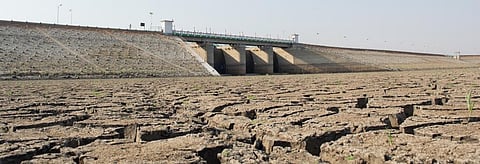

The live storage available in India’s 91 reservoirs for the week ended June 27, 2019, was 26.272 BCM (billion cubic metres), which is 16 per cent of total live storage capacity, the Central Water Commission (CWC) reported on June 27.
As compared to last week’s figure of 27.265 BCM, this week’s storage dropped by 3.66 per cent.
Last year, the live storage available in these reservoirs for the corresponding period was 29.612 BCM and the average of the last 10 years’ live storage was 30.708 BCM.
Thus, the live storage available in 91 reservoirs as on June 27 was 89 per cent of the live storage of the corresponding period of last year and 86 per cent of the storage of the average of the last 10 years.
Out of 91 reservoirs, 29 reported more than 80 per cent of normal storage, while 62 reported 80 per cent or below of normal storage. ‘Normal storage’ means average storage of the last 10 years.
All southern states as well as the western states of Maharashtra and Gujarat remain to the most severely affected by the water crisis. 57 reservoirs in these areas (27 in western India and 30 in southern) hold less than 40 per cent water.
The water shortage of Andhra Pradesh has risen to worrisome levels at 84 per cent, and similarly in Maharashtra, water deficiency is reported at 77 per cent.
Rivers
The major rivers in the southern and western zones like the Sabarmati, the rivers of Kutch, Godavari, Cauvery and the west-flowing rivers of southern India are flowing dry, with minimal to no water storage in them, the CWC said.
The Tapi and Krishna are witnessing massive deficits of about 82 and 62 per cent respectively.
Rivers in the eastern states of Jharkhand, Odisha, West Bengal and Tripura do not paint a very positive picture either. The total live storage available in the reservoirs in these states is 2.83 BCM, which is 15 per cent of their total live storage capacity.
On the other hand, the basins of the Indus, Narmada, Mahanadi and neighbouring eastern flowing rivers have witnessed a better than or close to normal storage position.
While the situation in the majority of large reservoirs is very grave, 19 reservoirs have increased storage as compared to last year. Twenty-one others hold storage more than the average of the last ten years.
India has so far received only 92.4 mm rainfall against a normal of 144.3 mm — an overall deficit of 35 per cent.